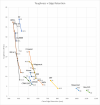They're similar and overlapping, yes, but there's nuance to be had there too.
I'm by no means an expert, so take what I say with a grain of salt, but abrasive wear resistance refers to wear induced by abrasive means only, i.e. cutting carpet, cardboard, items with silica, sand or other abrasives in them, etc.
This is often tested in the lab with CATRA testing though there are other tests as well.
In this test a knife cuts through a stack of silica impregnated strips of paper or card stock under a given load using slicing cuts. The steel is then given a rating based on how many pieces it cuts before it dulls sufficiently and can no longer cut under that given load. A higher rating (more cuts) means it has more abrasive wear resistance, lower and less abrasive wear resistance.
Steels with more hard carbides in them like S110V, 10V, Maxamet, etc will excel at this test as they can resist more wear than simpler steels like 52100, 1095, etc since they have a high alloying content of hard carbides in them. The simpler steels often have very little in the way of these alloying elements and carbides and so would dull much faster when cutting abrasive materials like rope and cardboard.
This test is limited in scope though since it only tests abrasive wear resistance. It doesn't test things like toughness, impact resistance, etc.
Here's the trade-off : while these highly alloyed steels have high abrasive wear resistance (from their carbide content), they don't often have high toughness and can dull by different means such as impacts to or side loading of the edge which could chip or roll the edge.
In real life, dulling happens through multiple modes, it's almost never purely abrasive in nature if it's EDC usage. So yes, your knife will encounter abrasion which can dull it but it can also be dulled by small or large impacts chipping it or from side loading the edge in cuts that aren't perfectly in line edge-to-spine which may lead to either chips or rolls.
For most of us, it's better to have a well rounded steel than one that specializes having high marks in only one particular area.
This is why steels like MC, D3V, S35VN, Cruwear, 4V/V4E are highly praised. They're not the best in any one area but they consistently have better than average ratings in most areas we care about like stainlessness, edge retention (resistance to all forms of dulling), and toughness. (Cruwear and 4V/V4E don't have great stainlessness, they're a lot better than say 52100 or 1095, but in the other 2 categories they're pretty darn good)
Your second to last sentence is spot on, we're not likely to notice a big difference in most uses, only in the more extreme use cases would certain attributes better show themselves.
Larrin's charts mostly just show the big 3 categories that are often talked about : abrasive wear resistance, toughness, and corrosion resistance or stainlessness.
There's other areas that we also care about which his charts don't really cover such as fine edge stability, strength, etc. Those are too specific for his chart's purposes though.
Nathan's tweaks or anyone's HT protocol in general has an effect on the steel which those charts won't always reflect. For instance, a harder blade typically has higher strength meaning the edge is more resistant to rolling than a softer blade (think glass or ceramic vs play-doh). Less rolling and deforming means higher edge retention but it doesn't mean it has higher abrasive wear resistance. See the difference?
Another instance is that a maker may HT to maximize carbide precipitation which would lead to higher abrasive wear resistance but toughness would likely be traded for such a goal.
As I understand it, Nathan's goal with his D3V protocol was to gain strength and edge stability because regular heat treated 3V doesn't have the greatest edge stability. It can roll easier than his delta protocol provides. I believe he was also gunning for increased toughness but can't recall if he's said that specifically or not so don't quote me on that. I think he's said the additional stainless it gained was a happy byproduct and not necessarily a goal of his tweaks.
In short though, his or anyone's heat treat protocols will effect those chart values to a degree, but some of it is baked in to the steel formulation so you won't ever be able turn something like 1095 into Maxamet. Much of it is determined by the steel's chemistry.
I like to think of it this way : Nathan has unlocked a lot of the steel's potential that others haven't yet been able to tap into. He can't exceed the fundamental boundaries of what the steel is capable of, but he's found the limits are higher than what we previously imagined.
I hope that is at least somewhat helpful and answers your question and I didn't ramble on explaining things you weren't asking.
 Nathan the Machinist
and users perspectives of one over the other.
Nathan the Machinist
and users perspectives of one over the other. 

